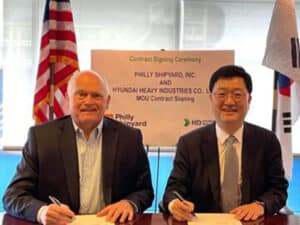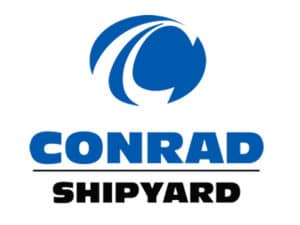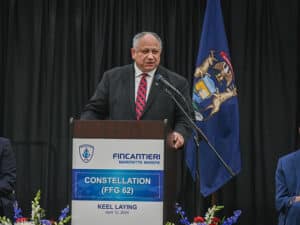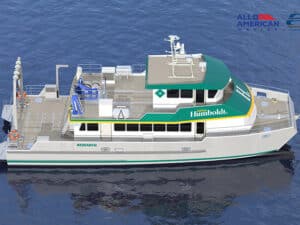
NASSCO starts construction of APT Jones Act tankers
Written by Marine Log Staff
San Diego Mayor Kevin Faulconer was in attendance at the steel cutting ceremony for the first of five 50,000 dwt product tankers for APT
SEPTEMBER 13, 2014—Activity at U.S. shipyards is booming and it’s nowhere more apparent than at the San Diego shipyard of General Dynamics NASSCO.
Yesterday the shipyard held a steel cutting ceremony for APT-1, the first of five LNG-ready 50,000 dwt product tankers for American Petroleum Tankers (APT), a subsidiary of Kinder Morgan Energy Partners, LP, Houston, TX.
San Diego Mayor Kevin Faulconer pushed a button signaling the start of construction of the 330,000 bbl Jones Act tanker. “This is a great opportunity to create hundreds of jobs in our burgeoning blue-tech industry,” says Mayor Faulconer. “By adding these good-paying jobs, NASSCO expands its role as a pillar of San Diego’s defense and innovation economies.”
NASSCO’s existing commercial backlog includes not only the five product tankers, but also three LNG-ready 50,000 dwt tankers for Seabulk Tankers Inc. and two dual-fueled 3,100-TEU containerships for TOTE, Inc. NASSCO’s workforce is expected to grow to about 3,500 to support the work.
Mayor Faulconer was joined by General Dynamics NASSCO executive leadership and representatives from Kinder Morgan Energy Partners, L.P., and Rob Kurz, Vice President of Kinder Morgan Terminals and President of KMP subsidiary American Petroleum Tankers.
When the last of the five 50,000 dwt tankers is delivered by NASSCO at the end of 2016, Kinder Morgan Energy Partners fleet will include 10 Jones Act vessels. Back in January, Kinder Morgan Energy Partners acquired APT and five State Class tankers for $916 million in cash.
Kevin Graney, Vice President and General Manager of General Dynamics NASSCO calls the APT vessels “the most energy-efficient tankers in the Jones Act fleet.”
The APT-1 is designed by DSEC, a subsidiary of Koreea’s Daewoo Shipbuilding & Marine Engineering (DSME), and will include improved fuel efficiency through several features, including a G-series MAN ME slow-speed main engine and an optimized hull form. The tankers will also have dual-fuel-capable auxiliary engines and the ability to accommodate future installation of an LNG fuel-gas system.





Leave a Reply
You must be logged in to post a comment.